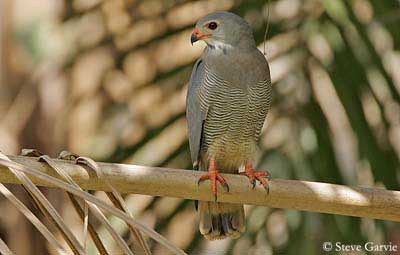
Text by Nicole Bouglouan
Photographers :
Roger Ahlman
Pbase Galleries Peru and Ecuador
Didier Buysse
Vision d’Oiseaux
Marc Chrétien
MURINUS
Maxime Dechelle
LEPAPARRAZO
Jean Michel Fenerole
Photos d’Oiseaux du monde
Steve Garvie
RAINBIRDER Photo galleries
Tom grey
Tom Grey's Bird Pictures
Patrick Ingremeau
TAMANDUA
Eduardo Andrés Jordan
MIS AVES – AVES DE ARGENTINA
René Lortie
http://rlortie.ca/
Niraj V. Mistry
Photo Galleries
Jean Michel Peers
JMPN PHOTOGRAPHIE
Philippe et Aline Wolfer
GALERIE
Sources :
HANDBOOK OF THE BIRDS OF THE WORLD Vol 2 by Josep del Hoyo-Andrew Elliot-Jordi Sargatal - Lynx Edicions - ISBN: 8487334156
BIRDS OF PREY OF AFRICA AND ITS ISLANDS by Alan and Meg Kemp - Struik Publishers - ISBN: 1770073698
BIRDS OF THE GAMBIA AND SENEGAL by Clive Barlow and Tim Wacher – Helm Field guides – ISBN: 0713675497
HAWKS, EAGLES AND FALCONS OF NORTH AMERICA by Paul A. Johnsgard - Smithsonian Institution Press - ISBN: 1560989467
L’ENCYCLOPEDIE MONDIALE DES OISEAUX - Dr Christopher M. Perrins - BORDAS - ISBN: 2040185607
Buzzards – Hawks – Buzzard-Eagle – Solitary Eagles
Leucopternis – Buteogallus – Parabuteo – Busarellus – Geranoetus – Harpyhaliaetus
Butastur (Africa and Asia) – Kaupifalco (Africa) – Asturina (Buteo nitidus)
The seventh group of the family Accipitridae includes nine genera throughout Americas, Africa and Asia.
Among these different species, the genus Kaupifalco with the Lizard Buzzard (Kaupifalco monogrammicus) has been recently associated with Melierax due to both behaviour and plumage, but finally, this raptor is more regularly related to the genera of the seventh group.
Another species, the Grey Hawk (Buteo nitidus) from Central and northern South America, is sometimes separated from Buteo and placed in the genus Asturina, and also included in the seventh group, due to its marked resemblance to Kaupifalco.
The Lizard Buzzard is a sub-Saharan African species. This small raptor is very similar in plumage to the stocky Melierax species, but it has a black line extending down the white throat. The plumage is pale grey overall, with white rump, barred grey and white lower underparts and white undertail-coverts. Flight feathers and rectrices are blackish, and we can see one or two broad white bars across the tail. The bill is black. Cere, legs and feet are orange-yellow. The eyes are red.
The juvenile shows brownish wash and brown-edged wing-coverts. The eyes are brown.
The Lizard Buzzard is also similar to some Leucopternis species from South America but it is paler overall.

Kaupifalco monogrammicus
This raptor is found in moist deciduous woodlands and along the riverine forests. During the rainy season, it frequents the savannahs. It feeds mainly on insects such as grasshoppers, and also lizards and snakes, frogs, rodents and some carrion.
It hunts from exposed perch. Once the prey is detected, it drops from the perch, making hard strikes, often in tall grass, before to swoop up to a new perch.
The Lizard Buzzard is vocal before the nesting period, calling and singing from open perches.
The stick nest is small, placed in outer fork of tree, and the cup is lined with lichen and leaves. The female lays two eggs and the incubation lasts about 33-34 days. The chicks fledge 40 days after hatching and still depend on parents during 30-40 days more.
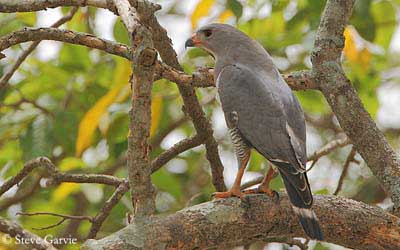
Kaupifalco monogrammicus
This species is resident is wooded areas, with some local post breeding movements into drier regions of S Africa during the dry season while moulting.
The Lizard Buzzard is common in the wooded regions of W Africa, and less abundant in others. The species is threatened by deforestation and destruction of grass cover by fires and grazing. But it has adapted and extended its range into primary forest areas.
The Grey Hawk is a medium-sized raptor with grey plumage overall. It may have fine dark grey barring above and white barring on the underparts. The tail is black and shows one or two conspicuous white bars.
The head is paler grey with black bill. Cere, legs and feet are yellow. The eyes are yellow or dark brown.
The immature is darker, blackish-brown above with white and brownish mottling. Underparts are buffy-white. The breast is streaked brown and the belly is spotted. The tail is brown and white-tipped, with darker bands.
There are four subspecies which differ in size, darker or paler grey plumage, and barring.

Grey Hawk
Buteo nitidus
The Grey Hawk frequents a great variety of habitats from lowlands and rainforest edges to arid, open country, from 600 to 1200 metres of elevation.
This raptor feeds mainly on lizards and snakes, but it also catches birds, rodents and large insects. It usually hunts from perches and it is very agile in forest where it is able to catch lizards from branches. The Grey Hawk is more powerful and rapid than the Roadside Hawk (Buteo magnirostris) to which it is sometimes associated, as well as the Red-shouldered Hawk (Buteo lineatus) and the Ridgway’s Hawk (Buteo ridgwayi), themselves closely related to Leucopternis species.
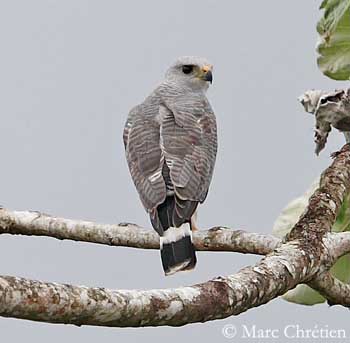
Grey Hawk
Buteo nitidus
It performs aerial displays with dives from great height (up to 500 metres) and chases. The stick nest is small and lined with twigs, placed high in tree at forest edge or in low thorny mesquite.
The female lays two eggs, but only one young is raised. The incubation lasts about one month and the chick fledges 42 days later. The nest area is aggressively defended.
The Grey hawk is sedentary in its range but the northern populations can be migratory.
This species is usually fairly widespread. It is able to adapt to the different habitats.
GENUS LEUCOPTERNIS
The genus Leucopternis of Central and South America includes 10 species, some of them very difficult to see due to their habits in dense vegetation. These hawks are small to medium-sized, and have short rounded wings, allowing them to move among the trees and to hunt in the forest.
They usually have black and white, or grey and white plumage.
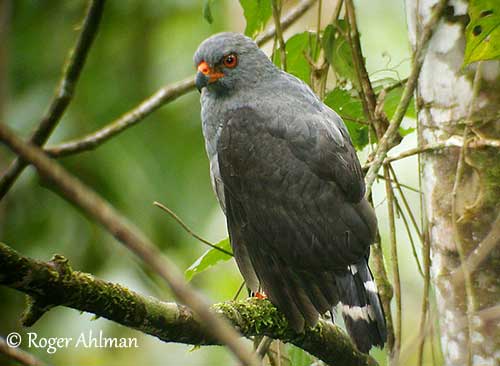
The Plumbeous Hawk (C. plumbeus) has slender body with relatively long legs and barred tail, making its silhouette fairly similar to that of the Crane Hawk (Geranospiza caerulescens). This one is placed in the fifth group because it shares several features with the harrier-hawks too.
However, the Plumbeous Hawk has uniform plumage above and below, except on the thighs which are finely barred paler grey. The bill is black. Cere, legs and feet are yellow-orange. The eyes are brownish-orange.
The Slate-coloured Hawk (Butoegallus schistaceus) is stockier than previous. It has grey body plumage overall, with black tail broadly barred and narrowly tipped white. The bill is black. Cere, eyes, legs and feet are yellowish-red.
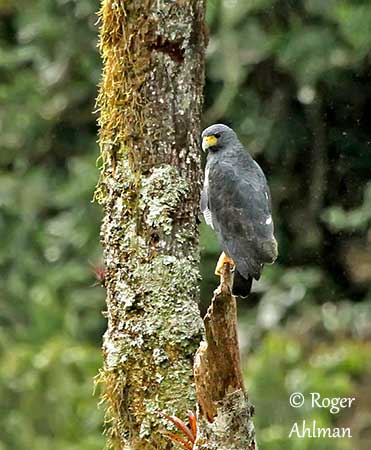
The Barred Hawk (Morphnarchus princeps) is larger and heavier. This one has black plumage on upperparts, head, throat and upper breast. We can see some bluish-slate edges on crown, nape and mantle. Underparts and underwing-coverts are white, narrowly barred black. The bill is black. Cere, legs and feet are yellow. Eyes are brown.
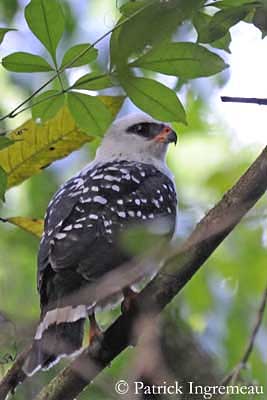
The Black-faced Hawk (Leucopternis melanops) has black and white plumage. It has white finely streaked black head, neck and upper back. The wings are black with conspicuously marked white wing-coverts and scapulars. A white band crosses the middle of the black tail. The underparts are white. The bill is black. Cere, legs and feet are orange-yellow. Eyes are grey or brown.
Leucopternis melanops
The White-browed Hawk (Leucopternis kuhli) has black upperparts with white streaks on nape and mantle, and only one white bar across the black tail. The underparts are white with grey wing tips barred black. The head is blackish with narrow white eye-stripe, giving the bird its name. The bill is black. Cere, legs and feet are orange. Eyes are brown to reddish-brown.
The White-necked Hawk (Buteogallus lacernulata) has white head and underparts, and blackish upperparts. The tail is black with very broad white bar and black narrow terminal band. This pattern makes it different from congeners. The bill is black. Cere, eyes, legs and feet are yellow.
The Semiplumbeous hawk (Leucopternis semiplumbea) is smaller and stocky. Upperparts and head are blackish, whereas underparts, including chin and throat, are white. The bill is black. Cere, legs and feet are reddish orange. Eyes are yellow.
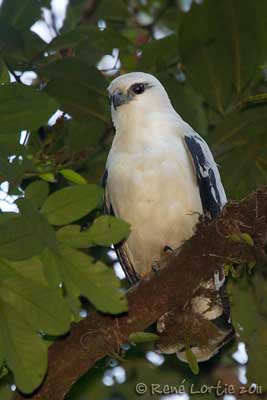
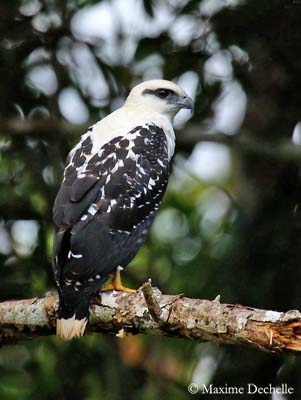
The White Hawk (Pseudastur albicollis) shows large variations of plumage from entirely white, to black above and white below. The underparts are always white, but wing-coverts and back may vary from all white to all black with narrow white streaks. The flight feathers are black. The tail may be white with thin or thick black bar, or black with white tip. The bill is black with dark grey cere. Legs and feet are yellow. Eyes vary according to the race, from yellow to brown.
The Grey-backed Hawk (Pseudastur occidentalis) has blackish-grey upperparts and white underparts. The head is grey with white-streaked nape. The tail is white with broad black subterminal band and narrow terminal white bar. This pattern is very different and separates this species from others. The bill is black with grey cere. Eyes are dark brown. Legs and feet are pale yellow.
The Mantled Hawk (Pseudastur polionota) has white underparts, upper back, head and neck. Rest of upperparts and tail base are bluish-slate. The second half of the tail is white, with different pattern than in other species. The flight feathers show white tips to primaries and secondaries. The bill is black. Cere, legs and feet are yellow. Eyes are brown.
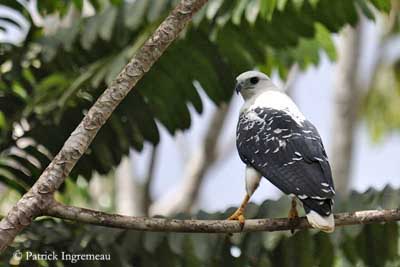
Pseudastur albicollis
In all species, the females are slightly larger than males, and immatures are more streaked or spotted than adults, and especially on belly and thighs.
They inhabit tropical rain forests, from lowland to mountains, and often favour the dense vegetation along streams and mangroves. They usually avoid the drier areas.
They hunt among trees in forest, and from perch along rivers. They may hunt from low perch and even on the ground when searching for insects or reptiles. The Grey-backed Hawk hunts over streams.
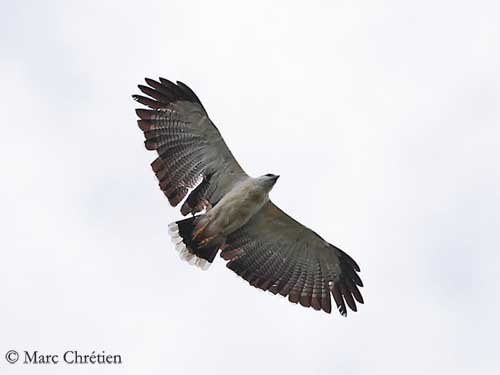
Pseudastur albicollis
They feed on amphibians, crabs, aquatic snakes, fish, reptiles, lizards, large insects, small mammals, birds, snails… According to the prey and the area, they hunt at different forest level.
There is very few information about the breeding and nesting behaviour of these species. Some nests have been recorded in crown of tall trees.
The White Hawk begins the courtship in February and the laying occurs in March. The female lays a single egg. Incubation lasts about 34-36 days. The young fledge at the beginning of the rainy season, about 80-90 days after hatching, suggesting extended dependency period.

Leucopternis melanops
All species are presumably sedentary in their range.
The statuses are very poorly known. The White-necked Hawk is Rare to Vulnerable, but occurs in protected reserves. The Grey-backed Hawk is considered Endangered. Several are near-threatened, but the densely vegetated habitat makes them very difficult to see. They are vulnerable to deforestation and they usually have restricted range. Surveys and research are required.
GENUS BUTASTUR
The genus Butastur includes four species from Africa, India and Southern Asia. They have browner plumage above and rufous-reddish underparts with streaks or not. The members of genus Butastur are fairly similar to kestrels in flight, and harriers at rest. Usually insectivorous, their diet is however varied with other typical raptors’ preys.
The Grasshopper Buzzard (Butastur rufipennis) from Sahel zone is a medium-sized raptor with rufous wing-coverts and underparts. Upperparts are brownish with blackish flight feathers. The tail is brown barred black. The undertail-coverts are white, as chin and upper throat. We can see fine black streaking on breast and upper belly. The bill is black. Cere, legs and feet are yellow. Eyes are pale yellow.
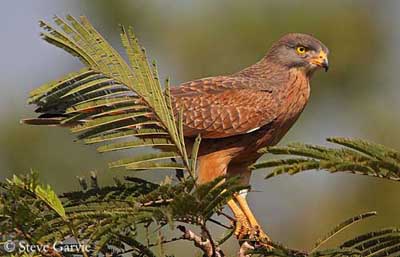
Butastur rufipennis
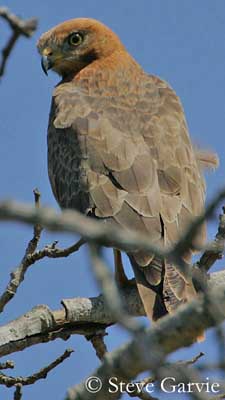
This species occurs in woodland and at forest edges, and also frequents arid, thorny savannahs. It takes advantage of bush-fires and burnt areas where it catches numerous insects, and especially grasshoppers, but mantids, beetles, stick insects, termites and spiders are much appreciated too.
It may take some small birds, rodents and reptiles. It hunts from perch from where it catches preys on the ground, and also hawks insects while flying in buoyant manner.
The Grasshopper Buzzard breeds in March-April and the laying occurs during the rainy season. The pairs are territorial. The nest is build with sticks in tree-fork, and the cup is lined with green leaves. The female lays 1-3 eggs. The nesting behaviour is currently unknown.
This species is an intra-African sub-Saharan migrant, moving southwards when fires and grazing reduce the vegetal cover. This raptor is locally abundant in W Africa during the dry season. It is vulnerable to overgrazing and drought in Sahel zone but it is also known to take advantage of local food sources.
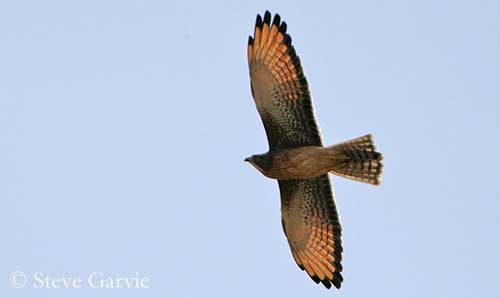
The Rufous-winged Buzzard (Butastur liventer) from southern Asia is brown overall, with rufous tail, uppertail-coverts and wings. Very similar to Buteo species, it has white lower belly with indistinct bars on flanks. The bare parts are similar to previous.
It frequents open country, savannah and scrub. In lowlands, it can be seen near rivers and swamps, but also up to 800 metres of elevation. It may be found near habitations.
This species feeds typically on small mammals, amphibians, lizards, crustaceans and insects. It also hunts from perch, swooping down onto the prey on the ground.
It breeds between February and April according to the range. The nest is large and built by both adults in tree crown, and the cup is lined with leaves. The laying is usually of 2-3 eggs.
The Rufous-winged Buzzard is sedentary in its range. It is locally common according to the location.
The Grey-faced Buzzard (Butastur indicus) from southern Asia has more contrasted plumage with rufous-brown upperparts and upper breast. Rest of underparts and thighs are white conspicuously barred rufous. The throat is white with black median streak. The tail is brown barred blackish. The head is greyish-brown with white eye-stripe, lores and forehead. The bare parts are similar to previous species.
This raptor frequents the wooded areas near open country and water, marshes and ricefields where it can find numerous preys. It is mainly found in low mountains, hills and foothills rather than flat areas. It prefers mixed woodlands.
It feeds typically on the same preys than previous raptors, and also hunts from perch, at top of dead tree, from which it swoops down onto the prey. It hunts mainly in the morning and the evening.
It breeds in May. The nest is fairly small and made with twigs and sometimes sedges, placed in conifer between 4 and 14 metres above the ground. The cup is lined with bark, grass and green leaves.
The female lays 2-4 eggs and the incubation lasts 28-30 days. The young fledge at 34-36 days, and still depend on parents for some weeks more.
This species is migratory, and travels in large flocks of thousands of birds from Japan to Taiwan S to Philippines, following the route along the Pacific coast of Japan.
This species is not globally threatened but the statuses are very poorly known.
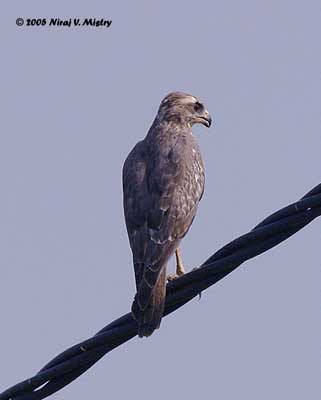
The last member of the genus Butastur is an Indian species. The White-eyed Buzzard (Butastur teesa) ranges in SE Iran, Afghanistan and Pakistan through India and Nepal to Burma. This small raptor resembles the previous species. It has greyish-brown plumage with rufous-brown uppertail. The throat is white with blackish central stripe, and white nuchal patch. The upperwing-coverts have variable pale markings which are more conspicuous when the bird is perched. The head is brown. The bill is black with yellow cere. The eyes are white. Legs and feet are yellow.
White-eyed Buzzard - Juvenile with brown eyes
Butastur teesa
This species frequents cultivated areas and dry open country. It can be seen from lowlands up to 300 metres or more of elevation in the Himalayas. It feeds on the same preys, small mammals, frogs, lizards, snakes and large insects. It hunts from perch and makes short flights to the ground to catch them.
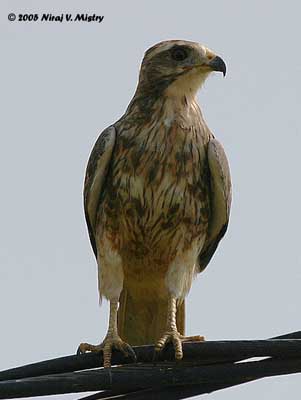
It breeds between February and May. The pair builds a loose, unlined nest at 8-12 metres of height in tall tree, often in village. Some displays such as the pair soaring over the territory while calling are reported. The female lays 2-3 eggs and incubates alone during about three weeks. The chicks are fed by both parents.
The White-eyed Buzzard is sedentary in its range, performing only some local movements.
The species is fairly common locally and not globally threatened.
White-eyed Buzzard - Juvenile with brown eyes
Butastur teesa
These four species are typical raptors, similar to Buteo species but with harrier appearance. Their feeding, hunting and nesting behaviour are those of most of birds of prey throughout the world, but they need more surveys and observations.
GENUS BUTEOGALLUS
The genus Buteogallus includes fives species from Mexico to Central and South America.
Two species, the Rufous Crab-hawk (Buteogallus aequinoctialis) and the Savanna Hawk (Buteogallus meridionalis), have more rufous plumage and slender body, than the three other species, the Common Black Hawk (Buteogallus anthracinus), the Mangrove Black Hawk (Buteogallus subtilis) and the Great Black Hawk (Buteogallus urubitinga) which have more blackish plumage.
They are medium-sized stocky raptors, with relatively long legs, broad wings and short tail. The long legs are adapted to their usual habitat near water, in mangroves, swamps and tidal flats, but also to their hunting behaviour by walking on the ground for some species.
Usually, females are larger than males. The young birds are browner than adults, with heavier mottling, streaking end barring.
The Common Black Hawk occurs in S USA, through Central America and islands to northern South America. It has blackish to deep grey-brown plumage overall according to the race. The short tail shows a broad white subterminal band and narrow tip. On the underparts, the bases of primary flight feathers are mottled white. The bill is black with yellow cere. Eyes are dark brown. Long legs and feet are bright yellow.

Buteogallus anthracinus
This species frequents dense, mature forests, and in the northern parts of the range, the habitat is dominated by mesquite. It can occur in hilly desert, but also in mangroves and tidal flats. Very dependent on prey availability, this hawk feeds mainly on reptiles and fish. Some amphibians, invertebrates and carrion can be added, but crabs are greatly appreciated in Costa Rica and Cuba.
The Common Black Hawk often soars in pairs, but it hunts from a perch or by walking on the ground, and attacks are usually initiated close to the ground.
They perform acrobatic flight displays. The bulky stick nest is lined with twigs and green vegetation, and placed between 5 and 33 metres high in mangrove or other trees. The female lays 1-3 eggs and both sexes incubate during 40 days. The young fledge about 43-50 days after hatching.

Buteogallus anthracinus
These raptors do not migrate, except the northernmost populations which leave the N Mexico and S USA to winter southwards. But their movements are poorly known. They are fairly common in their range and currently, they are not globally threatened.
The Mangrove Black Hawk is very similar to the previous, but slightly smaller and darker, with sooty black plumage overall. The tail shows a broad white median bar and narrow terminal band. The flight feathers are rufous-black and on the underwing, the bases of primaries show whiter mottling.
It occurs in the Pacific coastal regions of Central America to Colombia and N Peru. It frequents mangrove swamps and beach scrub, and breeds mainly in mangroves. It feeds primarily on crabs, fish and sometimes carrion.
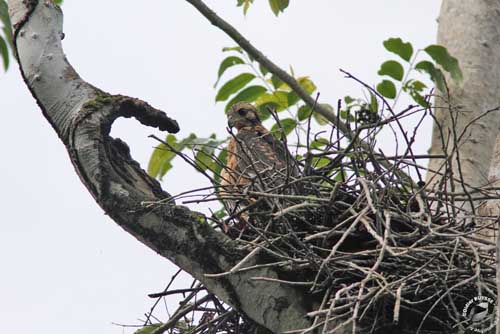
Mangrove Black Hawk
Buteogallus subtilis
Young at nest
The breeding behaviour is unknown, but the species is sedentary in its range. The statuses are poorly known, but this species appears fairly common locally.
The Great Black Hawk is the largest with a length of 64 centimetres. It has dull black plumage overall except the white tail barred by broad subterminal black bar and narrowly tipped white. The bill is black with dull yellow cere. The eyes are dark brown to red. The very long legs and the short toes are dull yellow.
This hawk is mainly sedentary in its wide range, from Mexico S to Central America, half northern South America and Pacific coastal regions to Peru.
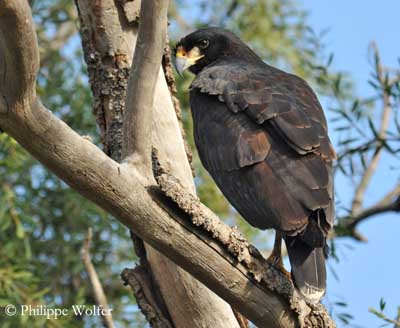
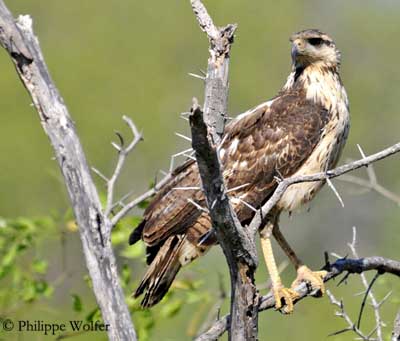
It frequents varied types of habitats from dry Chaco to rainforest, savannahs and old pastures with scattered trees and gallery forest, usually near water. It feeds on numerous food items such as rodents and birds, fish, crabs, amphibians and carrion. It may hunt small to medium-sized birds. It forages in forested areas from the ground to the canopy, and also at forest edges, in marshy areas and open country. Its long legs allow it to catch preys in shallow water after short flights among aquatic vegetation.
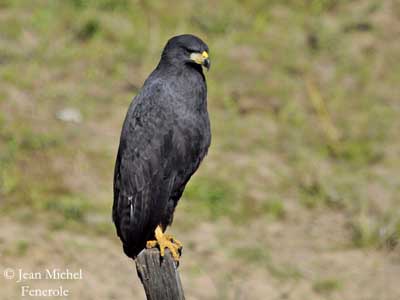
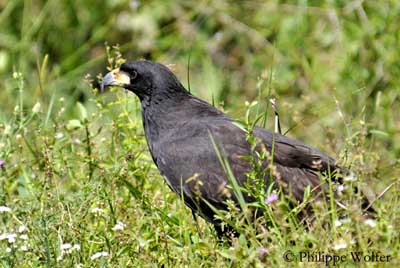
The Great Black Hawk breeds mainly during the rainy season. The nest in made with sticks and placed in trees, on power poles or above the nest of Monk Parakeets (Myiopsitta monachus). The female lays one or two eggs, but usually, only one chick is reared. Incubation lasts about 40 days. The post-fledging period appears fairly long with the young remaining dependent for food during several months.
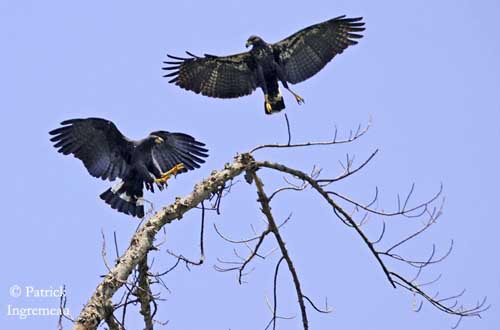
Buteogallus urubitinga
This species is widely distributed and able to adapt to modified habitats. The populations are not currently threatened.
The two following species are slightly slender than previous, but they share the same behaviour and types of habitats.
The Rufous Crab-hawk has sooty black upper body including head, throat and hindneck, whereas wings and back are deep grey-brown with rufous edges. The tail is black with narrow subterminal white band and terminal band. The underparts are rufous with dark brown barring. The bill is black with yellow cere. Eyes are brown. Legs and feet are yellow.
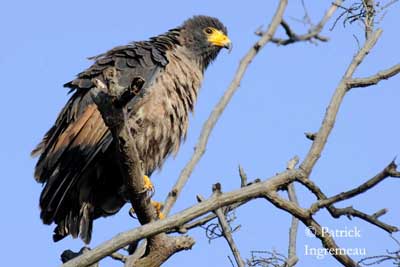
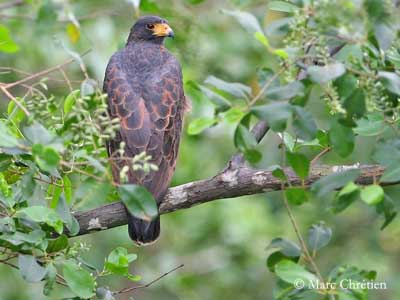
This species favours more aquatic habitats such as coastal swamps, mangroves, river edges or wet savannahs. It feeds primarily on crabs, caught after a short dive from perch. They are eaten on low branch or dry ground, and the raptor often uses the same perch.
It breeds during the rainy season during which some aerial and vocal displays are observed. The nest is made with twigs and lined with green leaves. Usually a single egg is laid, sometimes two. This hawk is often seen in pairs.
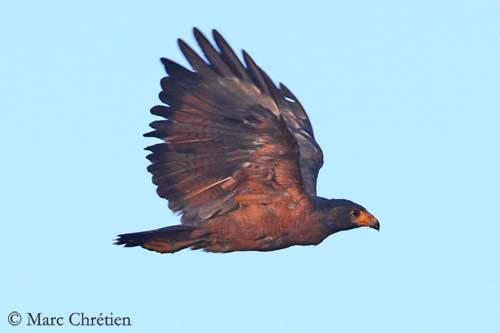
Buteogallus aequinoctialis
The Rufous Crab-hawk is sedentary and common within its range in mangroves, but it could be vulnerable due to the restricted habitat.
The Savanna Hawk occurs in the half northern part of South America. It has rufous to cinnamon plumage overall. The upperparts show fine streaks on hindneck, and the back is fuscous-brown with rufous edges. The paler underparts are finely barred black, but throat and chin are uniform. Thighs and undertail-coverts are rufous-cinnamon. The black tail shows narrow white median bar and tip. The bill is black with pale yellow cere. Eyes are reddish-yellow to pale brown. Legs and feet are pale orange-yellow.
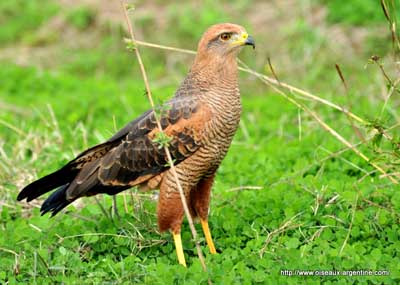
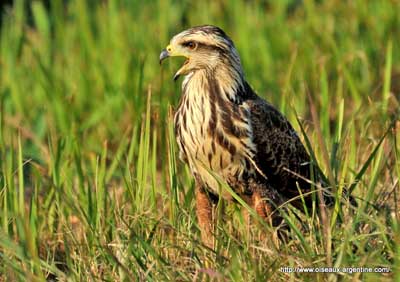
This hawk can be seen up to 1000 metres in Colombia, but it usually frequents open country, swamps, forest edges, wooded savannahs and mangroves, often near water. This opportunistic species feeds on wide range of food items such as small mammals, birds, crabs, amphibians, reptiles and large insects. It hunts from low perch and swoops down clumsily onto the prey, but it is also an agile predator, catching numerous birds according to the range. It also feeds at grass fires by walking, searching for preys a few metres behind the fire.
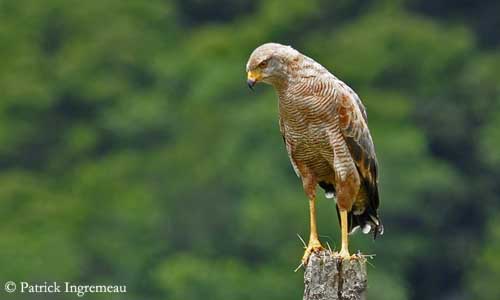
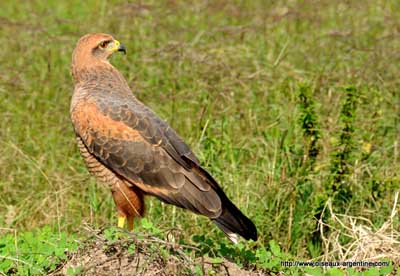
Buteogallus meridionalis
The laying occurs during the rainy season, with a single egg laid in stick nest in isolated tree. Incubation lasts 40 days and the young fledge about 45-50 days after hatching. It depends on parents during 4-7 months.
The Savanna Hawk is resident in most parts of the range, but the southern populations seem to be migratory, probably due to water levels and preys’ availability.
The species is secure and usually common in savannahs.
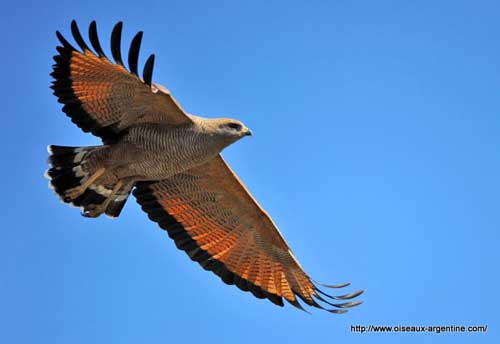
Buteogallus meridionalis
The members of genus Buteogallus, as the previous genus Butastur, often hunt from perches and feed on numerous prey items, from aquatic to more terrestrial preys. The long legs are very well adapted to this behaviour.
GENUS PARABUTEO
This genus has a single species, the Harris’ Hawk (Parabuteo unicinctus) which occurs from SW USA, through Central America to South America, except Brazil, the Andes and extreme south.
Very similar to the Rufous Crab-hawk, this elegant raptor has black and rufous plumage. We can see conspicuous chestnut patches on shoulders, thighs and underwing-coverts. The long black tail has white base and narrow white terminal band. The bill is black with yellow cere. Eyes are brown. Legs and feet are yellow.
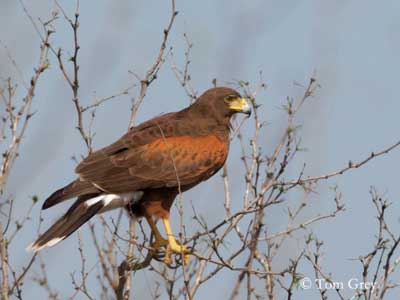
Parabuteo unicinctus
This hawk frequents both dry areas such as desert, savannahs and Chaco, and also swampy areas, according to the season. In more arid habitats, it can be often seen close to large water bodies. This species occurs between 1000 and 1900 metres of elevation.
It feeds on larger preys than the previous species, taking mammals such as rabbits and birds such as guans and rails. But according to the location, this opportunistic hawk catches preys which are abundant and available, but it does not take snakes.
It performs co-operative hunting in family groups for larger preys, and groups of 2-6 birds gather at dawn to hunt together.
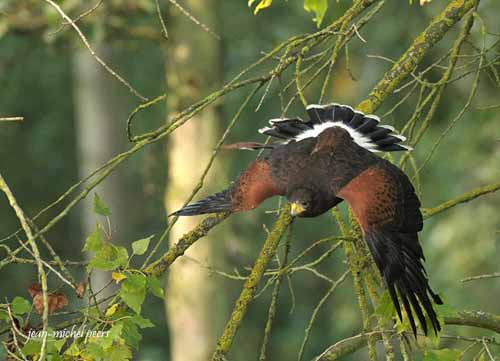
Parabuteo unicinctus
The Harris’ Hawk also performs co-operative breeding in some parts of the range. The nest is built in trees, mesquite, saguaro cactus and even human structures. It is made with sticks and lined with shoots, leaves, moss and other soft materials.
The female lays 2-4 eggs and the incubation lasts about 33-36 days. The chicks fledge 40 days after hatching, and they remain near the nest for 3-4 months after fledging. During the breeding season, each group remains within its territory and defends it.
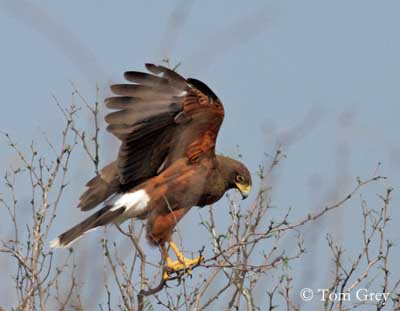
Parabuteo unicinctus
This species is mainly sedentary, but some birds may be nomadic at limits of the range, probably in response to prey availability.
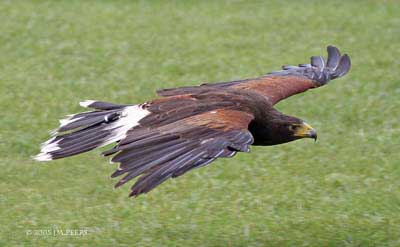
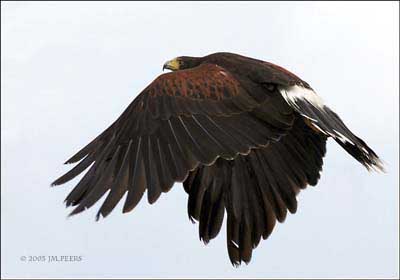
The Harris’ Hawk is fairly common to locally common according to the range. It is threatened by habitat loss, but this species shows broad tolerance to habitat and food, and is able to adapt to changes in the habitat.
GENUS BUSARELLUS
Only one species too in this genus, with the Black-collared Hawk (Busarellus nigricollis). This hawk is related to Buteogallus and Parabuteo. This species is found in Mexico, through Central America to South America, except the Pacific coast and the extreme south of the continent.
With a size of 50 centimetres in length, this raptor resembles to previous. It also has broad wings and short tail. The body is bright rufous-cinnamon, with black fine streaks on the back. The primary flight feathers and the tail are black. The latter is narrowly barred fuscous-brown.
Head and neck are buffy-white to whitish, slightly streaked above. We can see a conspicuous black breast band.
The bill is black with bluish-black cere. Eyes are reddish-brown. Legs and feet are bluish-white.
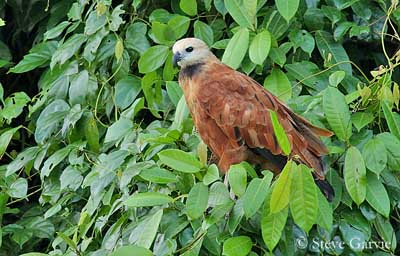
Black-collared Hawk - Busarellus nigricollis
The Black-collared Hawk is often found in tropical regions, near fresh or brackish water, and also from open country to dense humid forest along large rivers. It can be seen up to 500 metres of elevation in Colombia. This type of habitat provides it fish, aquatic insects and snails. It usually hunts from perch, from where it swoops down onto preys in shallow water or among the aquatic vegetation. This hawk has spiny feet, allowing it to grab the fish more easily.
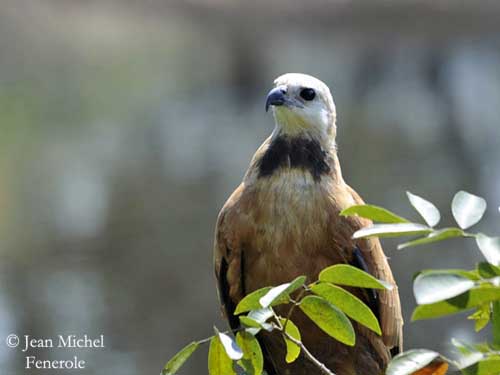
Busarellus nigricollis
The breeding season varies according to the range, but the nesting behaviour is poorly known. The stick nest is placed in mangroves or tall trees. The female lays a single egg.
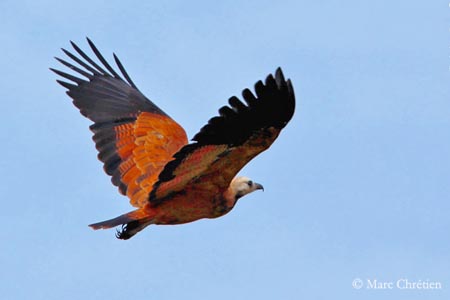
Busarellus nigricollis
This species is sedentary in its range, with some movements according to water levels. It is relatively common in suitable habitat, but the drainage of the wetlands in some parts of the range might be a threat in the future.
GENUS GERANOAETUS
The Black-chested Buzzard-eagle (Geranoaetus melanoleucus) was formerly placed in the genus Buteo. But this species is more closely related to Buteogallus and Leucopternis.
This stocky raptor is larger than the previous species, with a length of up to 80 centimetres, a weight of about 2000 grams and a large wingspan of up to 200 centimetres.
This species occurs in South America, along the Pacific coasts from north to south, and in S and E Brazil to Paraguay and E Argentina. Two races are recognized.
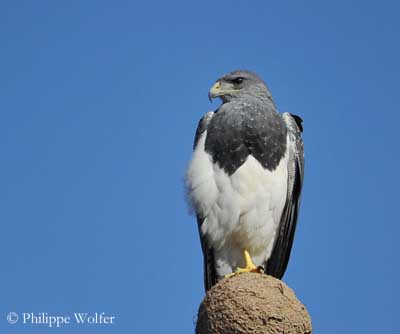
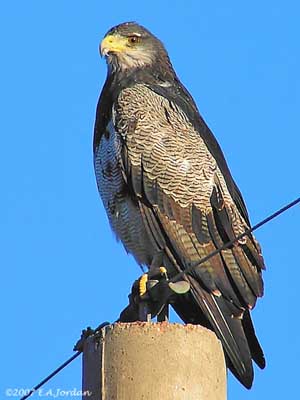
Black-chested Buzzard-eagle - Geranoaetus melanoleucus - Race melanoleucus left - Race australis right
The Black-chested Buzzard-eagle has long and broad wings, and short, wedge-shaped tail. Head and back are deep sooty-brown to slate black. The shoulders are paler and finely barred black. The upperwing is grey narrowly barred darker grey, and the black tail is narrowly tipped pale greyish. On the underparts, the breast is dark grey, with paler chin and throat, and belly and undertail-coverts are white, sometimes finely barred. The bill is yellow tipped black, with yellow cere. The eyes are brown. Legs and feet are yellow.
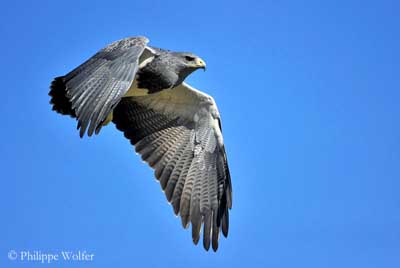
Geranoaetus melanoleucus
This raptor frequents the mountainous areas in the northern parts of the range, occurring up to 1600-3500 metres of elevation in Colombia, and sometimes higher, up to 4600 metres. Southwards, it frequents lowlands, grassy foothills, valleys, shrubby steppes and woodlands.
It feeds mainly on mammals such as rabbits but also larger preys, some birds such as Burrowing Owls and carrion. According to the season, it may take insects, some snakes and lizards.
It detects its preys while soaring, often in pairs, along slopes and ridge tops.
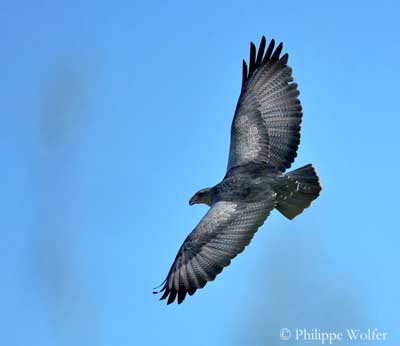
Geranoaetus melanoleucus
The Black-chested Buzzard-eagle performs aerial displays. It nests very high on cliffs, but also in lower areas. The nest is built with sticks at treetop, or on cacti and low bushes according to the availability. The female lays 1-3 eggs and the incubation lasts about one month.

Geranoaetus melanoleucus
The species is probably sedentary in its range, with any movement recorded. It is usually fairly common in its range.
GENUS HARPYHALIAETUS - Today, both species are in the genus Buteogallus
This genus includes two species, the Black Solitary Eagle (Buteogallus solitarius) and the Crowned Solitary Eagle (Harpyhaliaetus coronatus). Both species are closely related to Buteogallus in which they are now included, following the new taxonomy.
The Black Solitary Eagle is found from W Mexico, through Central America to Colombia, E to N Venezuela and S to NW Argentina.
This raptor is very similar to the Great Black Hawk, but it has paler plumage, and it is larger and heavier with a length of 71 centimetres and a weight of 3000 grams.
The body is dark slate grey overall. The short tail has broad white median bar and narrow white tip. On the head, the short crest is very inconspicuous. The bill is black with yellow cere. The eyes are yellow. Legs and feet are yellow.
It frequents the forests on mountain slopes and in Mexico, it can be found in tropical deciduous forests between 750 and 2500 metres of elevation.
Its feeding behaviour is poorly known, but it seems to take mainly snakes and probably some birds at nest.
The breeding habits are unknown too. One nest has been seen in the fork of tall tree on steep slope of wooded canyon, made with sticks and green vegetation. Another nest was found only one metre above the ground. Only one egg reported.
This raptor is probably sedentary in its range. The species is currently considered Near-Threatened. It is very rare but its status needs more information.
The other species, the Crowned Solitary Eagle is large too with a length of 75-85 cm for the same weight. This one is found in South America in E Bolivia, W Paraguay and S Brazil to S Argentina.
It has broad wings, short squared tail and long legs. This raptor is paler than the Black Solitary Eagle, and shows prominent crest. The plumage is dark grey or ashy brown overall. The black tail shows broad white median bar and narrow white tip.
The bill is blackish with yellow cere. The eyes are reddish-brown. Legs and feet are yellow.
The immature shows more markings and the same crest.
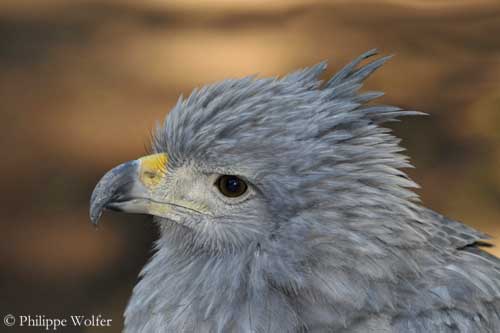
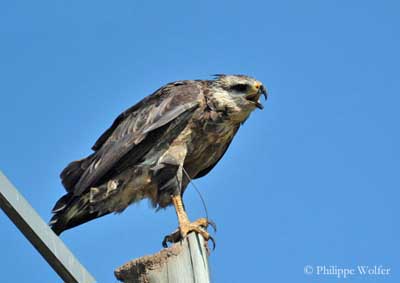
Crowned Solitary Eagle
Buteogallus coronatus
This species frequents dry shrub Chaco and caatinga (thorny seasonal forest) and moist Pantanal and palm savannahs. It also can be seen at forest edges.
It feeds on small mammals such as rodents, and also reptiles, birds and carrion. It hunts from low perch often at dusk. It has short toes, usually adapted for killing snakes.
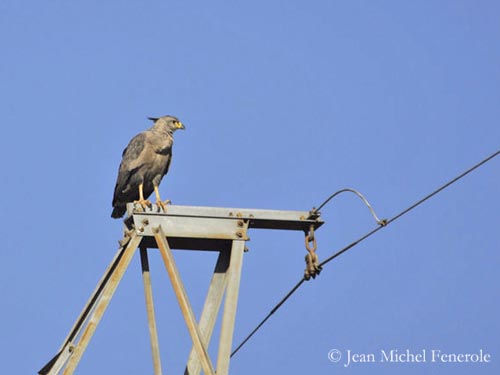
Crowned Solitary Eagle
Buteogallus coronatus
The laying, only one egg, occurs in October in large stick nest, sometimes built on top of Monk Parakeet colonial nest.
The species is mainly sedentary, but some northwards movements occur in the southernmost parts of the range in winter.
This raptor is considered Vulnerable, occurring over wide range but at low densities. But the statuses are very poorly known.
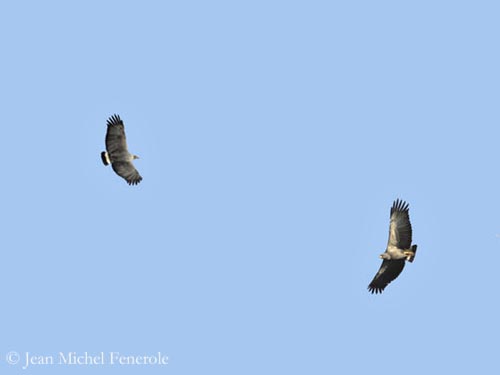
Crowned Solitary Eagle
Buteogallus coronatus
All these superb birds of prey lead us to the next group, the 8th, which will talk about the hawks of the genus Buteo, the most typical hawks.
MODIFICATIONS
Today, the genus Leucopternis contains only three species. Several species have been moved to other genera such as Cryptoleucopterix (Plumbeous Hawk), Morphnarchus (Barred Hawk), Pseudastur (Grey-backed Hawk, Mantled Hawk and White Hawk) and Buteogallus (White-necked Hawk and Slate-colored hawk).
Three species remain in the genus Leucopternis, the White-browed Hawk, the Black-faced Hawk and the Semiplumbeous Hawk.